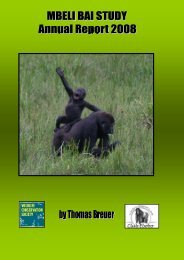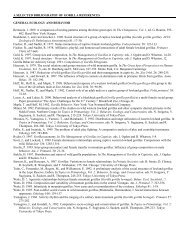First Prosimian Husbandry Workshop 2009 - Cleveland Metroparks ...
First Prosimian Husbandry Workshop 2009 - Cleveland Metroparks ...
First Prosimian Husbandry Workshop 2009 - Cleveland Metroparks ...
Create successful ePaper yourself
Turn your PDF publications into a flip-book with our unique Google optimized e-Paper software.
Response (Dawn Stone.): When off exhibit, pottos were in dark and moved around. Now we are<br />
experiencing with neutral density filter.<br />
Response (Chris Kuhar): It looks like a brown out and we didn’t turn off light. The blue light<br />
appears like white light to the animals.<br />
Question: What is a neutral density filter?<br />
Answer (Chris Kuhar): Reduces light, but doesn’t change spectrum.<br />
Response (Dawn Stone): We have bright lights during the pygmy slow loris day, but they prefer to<br />
come out during bright light then during their night.<br />
Comment (Briana Evarts): We are having guided tours through the nocturnal aye-aye exhibits. It<br />
is dark using blue light. As peoples eyes adjust, they can see the animals.<br />
Comment (Karen Weisenseel): Mesker Park has a great exhibit.<br />
Comment: If a white light burns out, animal will not come out.<br />
Question (Scott Gamerl): Can it be less binary, instead of just red and just blue? Light changes<br />
would be gradual.<br />
Moderator (Kris Arnold): This is occurring right now. There is an interest in doing temperature<br />
changes along with light cycles, it has helped with bats.<br />
Question (Chris Kuhar): What are Cincinnati’s white lights?<br />
Answer (Mike Dulaney): Most of it is a 4 ft fluorescent tube as white and one fluorescent tube of<br />
blue.<br />
Comment (Laura Suski): We can do whatever we want at DLC because of no public. We have a<br />
dense canopy over sleeping area by placing fleece blankets over their trees. Instead of going in the<br />
box, they prefer to be out in the open, but under this canopy. They took a shavings bag and putting<br />
it over the branch, without being a tight fit. This causes them to locomote a lot more. They prefer<br />
the brushier areas and they need a corridor of brush.<br />
Comment (Sue Rifai): A pygmy loris female has food in six different areas each day and she has to<br />
go out and look for it.<br />
Comment (Helena Fitch Snyder): If you spread gum on branches, they will spend a lot of time<br />
trying to get it.<br />
Response: We try jello and crickets.<br />
Response: You can put crickets in the fridge to help the prosimians get them.<br />
Response (Laura Suski): You can use fishing bait cages to get the crickets. The cage is a tubular<br />
bucket with a handle, usually wire mesh with a plastic rim on top and bottom, and plastic insert in<br />
middle. Animals can climb around and animal can use it to hunt.<br />
Comment (Kathleen Milk): Use red light, when used target stick animals responded more to a blue<br />
target.<br />
Comment (Adrienne Saunders): A hamster ball can be used for crickets. Has anybody used extra<br />
UV light?<br />
Response (Kathleen Milk): Use can lights or screw-in bulbs so provides dark corners for them.<br />
Response (Jim Metzinger): 500 watt light increases the heat.<br />
Question (Grace Fuller): Slow lorises like to roll in sawdust to improve coat, any thoughts on this?<br />
23




